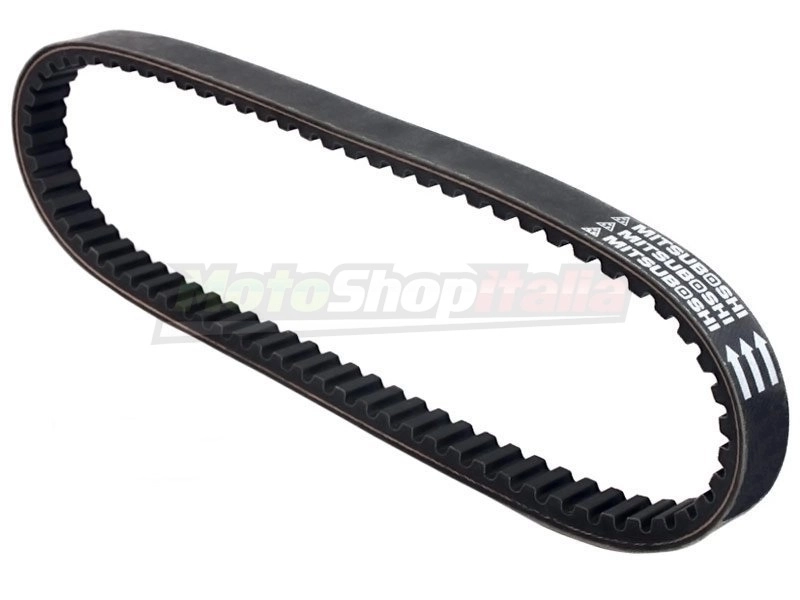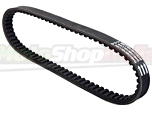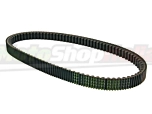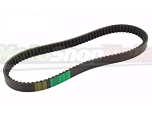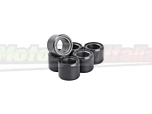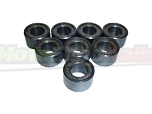Why It's Important to Replace the Belt and Rollers on Your Scooter
Replacing the belt and rollers on your scooter isn't just about regular maintenance. It's crucial for ensuring safety, efficiency, and longevity of your transport. Let's delve into the reasons.
The transmission belt is the heartbeat of your scooter. Without it, the engine couldn't transfer power to the rear wheel. Over time, however, the belt wears out. It thins, cracks, and in some cases, can even snap. Timely replacement prevents sudden stops and potential road hazards.
Rollers, on the other hand, play a vital role in speed variation. Worn out, they lose their original shape, negatively affecting vehicle performance. Replacing them ensures smoother riding and more responsive acceleration.
Signs That It's Time to Replace the Belt and Rollers
But how do you know when it's the right time for this maintenance? There are signs you shouldn't ignore. An increase in fuel consumption, for example, can indicate that the belt and rollers are overworking. A drop in performance, especially in acceleration, is another red flag. Finally, unusual noises from the engine compartment are often symptoms of wear.
Don't wait for these signs to become more serious problems. Preventive maintenance is the key to enjoying the freedom your scooter offers, without unpleasant surprises. Remember, safety starts with good maintenance. Replacing the belt and rollers at the right time is about taking care of not just your scooter but also yourself.
What You Need to Start the Replacement of Belt and Rollers?
Before you start working on your scooter for the belt and roller replacement, it's essential to have everything you need at hand.
A good start is half the work, as they say. Here's a list of necessary tools and some tips on where to buy the right spare parts.
To begin, you'll need:
- Socket wrenches: indispensable for dismantling parts of your scooter.
- Screwdriver: useful for opening the transmission compartment.
- Torch or lamp: to light up the darker corners of the engine.
- Work gloves: to protect your hands.
- Caliper: to measure the thickness of the belt and assess wear.
Now, onto the spare parts. Quality is crucial. Poor quality parts can compromise your scooter's performance and, worse, your safety. That's why knowing where to buy is important. Our store prioritizes quality, and over the years, we've become one of the most famous stores for motorcycle and scooter parts and accessories.
First, check the official website of your scooter's manufacturer. Often, you'll find original parts perfectly compatible with your model. If the price is an issue, there are online stores specialized in scooter parts like ours. Here you can find good deals, but pay attention to reviews. Always read them to ensure the quality and reliability of the seller.
Another place to look is your trusted mechanic. They might have or know where to find the right parts for your scooter. Plus, they could offer useful advice on the replacement.
Preparing Your Scooter for Replacement
Venturing into your scooter's maintenance, especially when it comes to replacing the belt and rollers, requires utmost precision. And an attention to detail bordering on obsession. Safety? It must be your mantra. Every decision, every action, must go through this filter. To guide you, here are a series of steps designed for you. They will help you prepare and fine-tune your scooter. Thus, every phase of the work will flow smoothly, with safety always in the forefront.
- Choose the right place: First, find a suitable place to work. You need space to move and enough light to see what you're doing. A garage or even just an area of the yard will do fine, as long as the ground is flat and stable.
- Let the engine cool down: It's crucial to wait for the engine to cool down before starting work on the scooter. Working on hot components can be risky.
- Disconnect the battery: This step (disconnecting the scooter's battery) is crucial to avoid any risk of short circuits while working. Better safe than sorry, right?
- Organize your workspace: Having all tools and spare parts within reach will save you time and help you stay focused on the task at hand. An orderly environment is also safer.
- Protect yourself: Don't forget to wear sturdy gloves and safety glasses, especially if you plan to handle liquids or small and potentially dangerous components. Your safety can never be too much.
- Do a final check: Before you start, take a last look around. Make sure there are no obstacles and that the scooter is positioned stably. A last check can make a difference.
Remember, preparation is the key to a well-done maintenance job. Take your time to follow these steps, and you'll see the work proceed smoothly. And don't forget: safety first!
Guide to Replacing the Scooter Belt
Replacing your scooter's belt is not a task to be taken lightly. But with the right guide, you can do it. Here's how.
First step: Removing components to access the belt. Start by removing the outer cover of the engine compartment. Usually, it's just a few screws. Use a socket wrench or screwdriver, depending on the model. Done? Good, now you're in front of the heart of your scooter.
Look closely. The belt is there, hidden under other mechanical components. You might need to remove these too. Be careful. Each piece has its place. A good trick is to take photos with your phone. They will help you remember how to put everything back.
Now, it's time to assess the old belt. This step is crucial. Not all belts that look worn need to be changed. But there are unmistakable signs. Cracks? Obvious wear? If you notice these things, it's time to replace it with a new one. Even if you don't see visible damage, consider the age and miles traveled. Prevention is better than cure.
At this point, it's time for the installation of the new belt. Take the new belt and place it around the motor shaft and the pulley. It might seem a bit tight. That's normal. It takes a bit of force to get it on. But be careful not to force too much. The belt is sturdy, but not indestructible.
Once positioned, manually rotate the pulley to ensure the belt has settled well. It should turn smoothly, with no hitches. If you feel resistance or notice the belt moving strangely, check again. Better to lose a minute now than hours of work later.
Final step: Reassemble everything. Follow the photos you took at the beginning. Every screw, every component, must go back to its place. This step requires patience. But it's crucial. Once the cover is back on, give it a good clean. It seems trivial, but working on a clean vehicle is always more enjoyable.
There you go. You've just replaced the belt on your scooter. It wasn't that hard, was it? Remember, regular maintenance is the key to keeping your scooter in shape. And now that you know how to do it, why not take care of the rollers on your scooter too?
Guide to Replacing the Scooter Rollers
Replacing the variator rollers may seem complex, but with the right instructions, it becomes a breeze. Let's see how to do it together.
Start with the removal of the old rollers. First, you need to access the variator. This requires removing some parts of the scooter, as done for the belt. Once the variator is open, you'll find the rollers inside. Often there are six, but it depends on your scooter model. Take note of their placement; this will aid you during the installation of the new ones.
Remove the old rollers carefully. They might be worn or damaged, so be cautious not to scatter pieces or debris. Once removed, take the opportunity to clean the inside of the variator. A clean environment is essential for the proper functioning of the new rollers.
Now, choosing the right rollers. Not all rollers are the same. They vary in weight and size, affecting the scooter's performance. A lighter roller increases acceleration but may reduce top speed. A heavier roller does the opposite. The choice depends on your preferred driving style and the performance you want from your scooter. Consult your vehicle's manual or ask one of our professionals to make the right choice.
Moving on to the installation of the new rollers. Position them one by one in the variator, following the order and orientation of the old ones. Ensure they are properly seated in their places. A poorly placed roller can cause vibrations, noises, or, worse, damage to the variator.
Once all the rollers are inserted, it's time to close the variator and reassemble the parts you removed. Do everything calmly and attentively. Every component must return exactly where it was. A missing screw or a poorly mounted piece can create problems in the future.
All done, you've just replaced the rollers on your scooter. Now, let's look at some maintenance tips.
Maintenance Tips
Taking care of the belt and rollers on your scooter is crucial. It's not just about ensuring optimal performance but also about extending their lifespan. Here are some valuable tips.
- Regular Cleaning: It might seem trivial, but keeping the engine compartment clean makes a difference. Dust and debris can accelerate the wear of the belt and rollers. Periodic cleaning prevents harmful accumulations.
- Periodic Checks: Don't wait for signs of wear to take a look at the belt and rollers. A visual check now and then can help you spot problems before they become serious. Look for signs of wear, cracks on the belt, or rollers that appear irregular or worn.
- Lubrication: You know, your scooter's belt doesn't need oil, but the parts around it? They do. Check the manual, where you'll find everything you need: when and how to oil properly. It always does good.
- Careful Driving: Your driving style affects the lifespan of the belt and rollers. Sudden and continuous accelerations can unnecessarily stress these components. Smooth and regular driving helps keep them in good condition longer.
- Change in Advance: Maybe your belt and rollers still seem in shape, but they have an expiration date. Usually, the belt is changed between 20,000 and 30,000 km, rollers a bit earlier. But hey, it depends on how you drive and what scooter you have. The manual? It's your best friend in this step.
- Choose the Best: When it's time to change, don't skimp. Good replacements mean a happy scooter. Yes, they cost a bit more, but think about the performance and how long they'll last! In our store, you find the best motorcycle and scooter parts on the web.
- Watch for Signs: If your scooter starts to act up, consumes more or makes strange noises, it's time to take a look. Belt and rollers might be asking for help.
Remember, a bit of preventive care works wonders. Not just for the belt and rollers, but for the whole scooter. Thus, your ride will always be at the top, safe, and fun. And in the end, prevention is better than cure, right?
Troubleshooting Common Problems
Dealing with problems during or after the replacement of the belt and rollers on your scooter can seem like an insurmountable obstacle. But fear not, often the solution is simpler than you think. Here's how to navigate through the most common troubles, maintaining calm and efficiency.
If something goes wrong during the replacement:
- Stop and Assess: The first golden rule is not to rush. If you feel something isn't right, take a step back. Analyze the situation calmly.
- Check Your Tools: Sometimes, the problem is the wrong tool or not using it properly. Make sure you have everything you need at hand and that it's suitable for the task.
- Reread the Instructions: It seems trivial, but a review can make a difference. Maybe there's a detail you've missed.
After the replacement, common problems include:
- Unusual Vibrations: If you feel strange vibrations after the replacement, it might be a sign that the belt or rollers are not installed correctly. Check that everything is in its place and securely fastened.
- Loss of Power: A belt too tight or too loose can affect your scooter's performance. Check the tension and adjust it according to the manufacturer's specifications.
- Atypical Noises: A whistling or rubbing noise may indicate that the belt is not optimally positioned or that the rollers are not turning as they should. Open the compartment again and do a visual check to ensure everything is orderly.
How to identify and solve:
- Listen to Your Scooter: Often, your vehicle will tell you exactly where the problem is. Careful listening can guide you towards the solution.
- Visual Inspection: Never underestimate the power of a good look. Look for signs of wear, damage, or incorrect installation.
- Consult the Manual: Your scooter's manual is a goldmine of information. For every problem, there's almost always a dedicated section with suggested solutions.
Remember, maintaining your scooter isn't just about replacing parts. It's also knowing what to do when things don't go according to plan. With a calm, methodical, and informed approach, you'll be able to overcome any hiccup and keep your scooter in perfect running condition. And remember, experience comes with practice. Every problem solved is a lesson learned for the future.

 Italiano
Italiano
